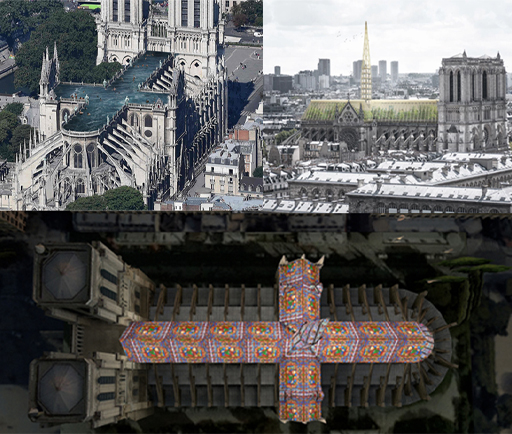1.3 Response to the fire
Sometimes when buildings are damaged or destroyed, they are simply ignored, leaving a pile of rubble as a reminder of what had occurred. On other occasions, the remnants may be demolished and removed to make way for brand new developments or replacements of the old building.
However, this was not the case with Notre-Dame. On the night of the fire, French President Emmanuel Macron publicly proclaimed that the cathedral would be rebuilt. Calling on talented people throughout the world to contribute to the project, Macron pledged that Notre-Dame would rise again, adding ‘It’s what the French expect. This is what our history deserves. This is our deep destiny.’
View Macron’s press conference [Tip: hold Ctrl and click a link to open it in a new tab. (Hide tip)] (make sure to open this link in a new tab/window so you can easily return to this page). After clicking through, scroll down to the video towards the bottom of the page.
Within a week of the fire, donations from all over the globe, totalling over €1 billion, were offered for the cathedral’s restoration. Some individual donations from wealthy families and corporations were over €10 million each, but a large number of smaller donations were also received.
Once the decision to rebuild was announced, the French Prime Minister Édouard Philippe called for a competition to be held to select the best architectural design for Notre-Dame’s new roof and spire. Suggestions and computer-generated mock-ups were quickly published, ranging from fairly traditional and modest plans to those which were rather more adventurous or bold. Among the latter group were proposals to build the entire roof out of crystal or stained glass, and to turn it into a greenhouse or a swimming pool.
Activity 2 Designing the new Notre-Dame
Discussion
Despite its popularity with architects, the competition was cut short due to mounting criticism from the international community and France itself. On 19 July 2019, the French Parliament passed a new bill requiring Notre-Dame’s restoration to mimic its exact appearance before the fire.
This restoration work is estimated to be an incredibly difficult and long-running project. This is because the newly built sections need to be made from material which matches the original building and must mesh with the existing structure without damaging or unbalancing it further.
Initially, President Macron promised that the project would be finished within five years. However, some architects have suggested that it could take 20 to 40 years to complete. In addition, some art insurers have predicted that the overall cost of restoring Notre-Dame will be around €7 billion.

